22 Feb November 2021: Tankless Water Heaters


Office: 843 846 2500
www.WillisSinclair.com
Info@WillisSinclair.com
November 2021
Number 93
We at Willis Sinclair wish you and your family the
Happiest of Thanksgivings!

Edith and George are discussing big issues in one of Gramma’s (Kandy’s) flower gardens.
From the … 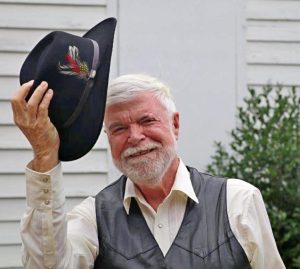 Desk of Bill
Desk of Bill
November 2021.
I hit a milestone this month. In just a few days, I’ll be ¾ of a century old. Somehow, I don’t feel that old, but calendars don’t (usually) lie.
It has been (and still is) quite a trip. I grew up in a home without an inside bathroom in the foothills of the Ozark mountains. The old home had four rooms, an unfinished small attic and a porch (plus an outhouse). It had no closets, no central heating (or cooling), no well (we had a cistern that collected rainwater from the roof), no phone, no paved roads, no neighbors (the closest one was about ½ mile away). We had a 15 amp electric service with one light and one outlet in each room. When my Daddy purchased an electric dryer for us, the power company had to special order a transformer – they did not have a “large” one in stock. The power company representative could not believe we needed so much power (a 30 amp service). (Typically, today the most common residential service is 200 amps.)
I went to a one room school (grades 1 to 8) for my first three years of school (we had two outhouses there: boys and girls). The teacher stopped by and picked up me and my brother a couple of the years. One year, we walked to school (about 1¼ miles each way, but at least it was not uphill both ways.)
In the fourth grade, our one room school closed (it dropped below the 12 students required to keep a one room school open) and I was bused to the nearest town (about 7 miles) where there were only two grades in my class and we had an inside bathroom at school!
When we moved to the St. Louis area and I was in the 7th grade I was finally in a classroom with a single grade. Not only did I have only one grade in my school class, but we had an indoor bathroom at home and at school!
I started college, but was interrupted by my uncle. He had a green uniform he wanted me to wear. I spent the next three years teaching other soldiers how to repair army tank engines. I worked hard and was promoted quickly ending up as a Staff Sergeant (E-6) within 23 months of service. I did my job well enough that my commanders chose to keep me at the Armor School rather than send me on an all expense paid trip to Vietnam.
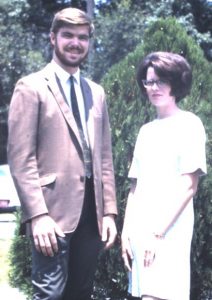
Me and my darlin’ companion about 53 years, 8 children and 37 grandchildren ago! Over the years, we have moved more than two dozen times, often with a lot of little people in tow. We have lived in Florida (a number of places), Kentucky, Arizona, Tennessee (several places) and South Carolina over the years. (The photo is a scan of an old Kodachrome slide, so the quality is not great.)
I also got married just before my college intermission. God blessed us with our first child just as I was being discharged and heading back to college, this time in Florida. We were blessed with a new bundle about every two years until we had eight little people. We had our first grandchild about 1997 and have added at least one and as many as four per year (except 1999 and 2018) for the next 24 years. We are now up to 37 grandchildren (and three of our girls are still at home).
Kandy and I began home schooling our children when Kathy (our oldest) was in the 3rd grade. Today, all of our children are homeschooling their children.
When I finally graduated from college, I had taken courses or attended about half a dozen colleges (as a resident, by extension or correspondence). I practiced engineering design work for the next 30 or 40 years.
I started designing weather radar systems for business jets at Bendix in Ft. Lauderdale. I remember working to rush out 6 or 8 radar systems for a new start up: FedEx, back about 1970. They had just a few small jets back then. I also helped hand build a system Bendix donated to Jacques Cousteau, the famous French oceanographer. Later, I designed the preamp for our commercial weather radar system that was used on most of the airlines in the free world. If you flew back in the 1970s, 80s or 90s, the chances are good some of the circuits I designed were aboard your aircraft.
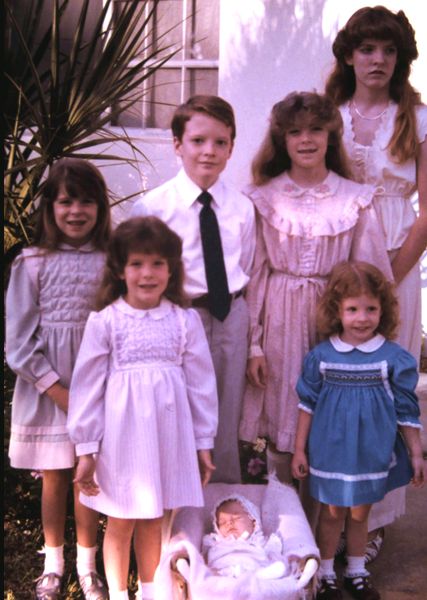
Late 1985.
Seven of our eight children.
From the left:
Debby (Willis’ wife),
Susie (lives in Tennessee),
Bill (lives in Missouri),
Mandy (in baby carrier),
Becky (Tennessee),
Abbey (in Blue) and
Kathy (Tennessee).
Jessy had not arrived yet.
Later, I worked on flight navigators and then televisions. Over the years, I was awarded six United States Patents.
A while after I left television design, my son and I started The Great Southern Engineering Company and did software and networking for several years. We ended up selling the company to our largest customer.
About fifteen years ago, I began working with Willis building houses. The company grew quickly and about 2007 we made the Inc. (magazine) fastest growing companies list. Then 2008 happened. We diversified from just building homes adding remodeling and other customer services. A couple of years ago, I sort of retired from working everyday for the company. I still do some back office work, but don’t actively supervise jobs any more.
I hope this does not sound boastful. It is certainly not meant to be. I am just an ordinary guy thinking about the past 75 years. I have tried to work hard, attempted to listen closely to God and do what I needed to do. The point is that if I can do it, most anyone can. I have had a lot of “ups” (blessings) and also a lot of “downs” (struggles – chances to grow).
Kandy and I are both the oldest living members of our families now – we have buried our parents. Alice, one of our granddaughters had a very serious bout with leukemia, but is doing well. We have had a lot of struggles, yet here we are. I am turning 75. Kandy is a bit younger. We celebrated our 53rd anniversary a few months ago. We are still active and planning a trip to the Springfield, Missouri area this month to visit our son and his family. God has been amazingly good to us. I pray he blesses you. I am sure we all have reasons to be thankful this Thanksgiving Season.
Water Heating
The largest user of energy in your home is very likely your HVAC (Heating, Ventilating and Air Conditioning) system. The second largest user of power is probably your water heating system. The U. S. Energy Information Administration (eia.gov) estimates about 30% of your electricity feeds your HVAC system. Another 14% is used to heat water. These are averages for residences in the United States.
Traditionally, water is heated in a large tank (30 to 50 gallons) using electricity (or sometimes gas). The water is kept hot 24/7 unless there is a timer (on a water heater using electricity as the source of heat) installed. The hot tank, even though it is insulated, continuously loses heat to the environment. The losses are not huge, but they are constant. That means you need to use power to keep the water hot just in case you want hot water. Perhaps that is not the best design.
What options are available for heating water?
While tank water heaters are by far the most common, tankless water heaters are being installed frequently in our area. A tankless water heater removes the constant heating of water.
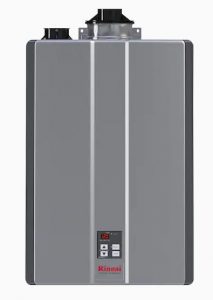
This is how a typical tankless water heater looks. Gas and water connections are at the bottom. The exhaust is at the top. This particular water heater is 199,000 BTU and can heat about 10 gallons of water per minute. For comparison, the federal government restricts the flow rate of a shower to 2.5 gallons per minute. Since you are probably not using full hot water, the flow rate through the water heater would probably be closer to 1 gallon per minute.
The tankless water heater heats water as it is being used, so heat (think energy) losses don’t happen when there is no hot water demand. While that is a good idea, there are drawbacks to tankless water heaters. Perhaps the first is cost. A tankless water heater is around $2,000 (for a 9.8 gallon per minute 199,000 BTU water heater) installed (if you have propane available). If you don’t have a propane tank, then you need to figure another few thousand to have an LP tank installed, plumbed and filled.
One down side of the tankless water heater is that since it is not heating when it is not being used, getting hot water to the delivery point takes a bit longer. First the water heater has to ignite then hot water has to flow to the delivery point. True, with tank water heaters, there is some delay to get hot water (unless you have a circulation system), but the delay is shorter since hot water is available in the tank. It is not uncommon for us to install more than one tankless water heater, particularly if baths are at separate ends of a house.
As mentioned, a circulation system will minimize the delay time for a traditional water heating system, but does little for a tankless system since there is no hot water to circulate unless hot water is demanded.
Tankless water heaters also require a certain flow rates (perhaps ½ gallon per minute) to ignite and start heating water. If you draw less than the minimum, the heater will go back to the off state. Ironically, if you turn the heat up too high at the water heater (using an available remote control), you need much less hot water to mix with the cold water to get the temperature you want. If you draw less than the minimum, the tankless heater will turn off and you will have all cold water – not a nice surprise. Fortunately, this is easy to correct: set the water temperature at the water heater lower. That way more (not so hot) hot water is needed and you are well above the minimum flow rate.
Another possible issue with tankless water heaters is that there is no limit to the amount of hot water you can use (until you run out of water or propane). Hour long steamy showers are possible. That may be good and that may not be so good if you have someone who likes to camp out in a nice steamy shower.
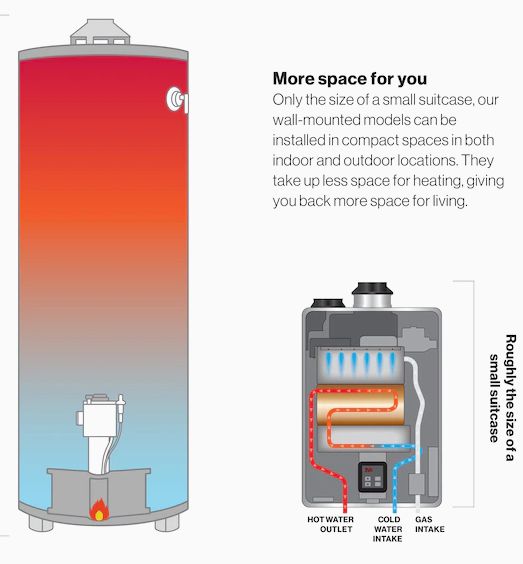
A tankless heater is considerably smaller than a traditional tank water heater.
Tankless water heaters can be installed inside or outside. Given the option, personally, outside seems to be the better choice to me. I would rather have any gas appliance outside if it is possible. (Clearly ranges, inside fireplaces and other devices must be inside.) There are several reasons. One, excess heat from the water heater can dissipate outside with no problem. If the excess heat is inside, it is a load on your air conditioner. Although gas (propane) leaks are very rare, if your heater is outside and leaks propane, it is no hazard. Inside, if you home fills with propane and there is a spark that is bad news. Again, propane leaks very seldom occur and propane has a distinctive smell. (Actually the fragrance mixed with propane is what you smell. The gas itself is odorless.) If you are not home, you cannot notice the odor.
The exhaust when propane is burned also has a smell that many people find objectionable. That should not be a problem if the water heater is installed correctly. With it outside, it won’t be a problem.
There is also the space issue. If the water heater is outside, it won’t take up any space in your home. Noise is another reason it might be good to put the tankless heater outside. Although they are not loud, they are not totally silent either. All that being said, many people install water heaters inside their homes with no problems.
If you want to retrofit your home with a tankless heater, it may be easy or not so easy depending on your situation. If you have a gas tank water heater, the change out should be relatively easy. In the water heater closet, you would have propane, a hot water line and a cold water line. If you have an electric water heater, you have to get propane to a tankless water heater location.
A tankless water heater has much less time to heat water than a conventional tank water heater, thus its heat source has to be much hotter than a tank water heater. The tank water heater takes an hour or more to heat 50 gallons of water, so less peak energy is needed. A tankless water heater like we install (a large residential) will heat roughly 10 gallons per minute.
Typically, a tank electric water heater has a 5,400 watt heating element. That translates to about 18,500 BTU/hour. The tankless water heaters we often install are rated at 199,000 BTU/hour or ten times as high as tank water heaters.
Speaking of getting propane to a tankless water heater, there are also tankless electric water heaters. They are not very popular because they use a large amount of power. To heat water, you have to have an energy source (propane or electricity) to create heat. Since the water is exposed to the heat source for a short time as it flows to your faucet, the heat source has to be a very large one. That is not a problem for propane, but electrical heat sources present more of a challenge. Large wires are needed and a robust electrical service.
So, should you switch to a tankless water heater? If you currently have a gas water heater and you decide to install the tankless water heater in the same location, the installation should be relatively simple. If you have an electric tank heater, you will need some way to get a propane line to the location of the tankless heater. You will also have to figure out how to route hot and cold water lines to the same location.
A tankless water heater will probably save you money over the long run. It does have a higher up front cost, but is more efficient. If you are considering a tankless heater, don’t hesitate to call us (843 846 2500) we will be happy to look at your situation and give you our thoughts. Call us. We can help.





No Comments